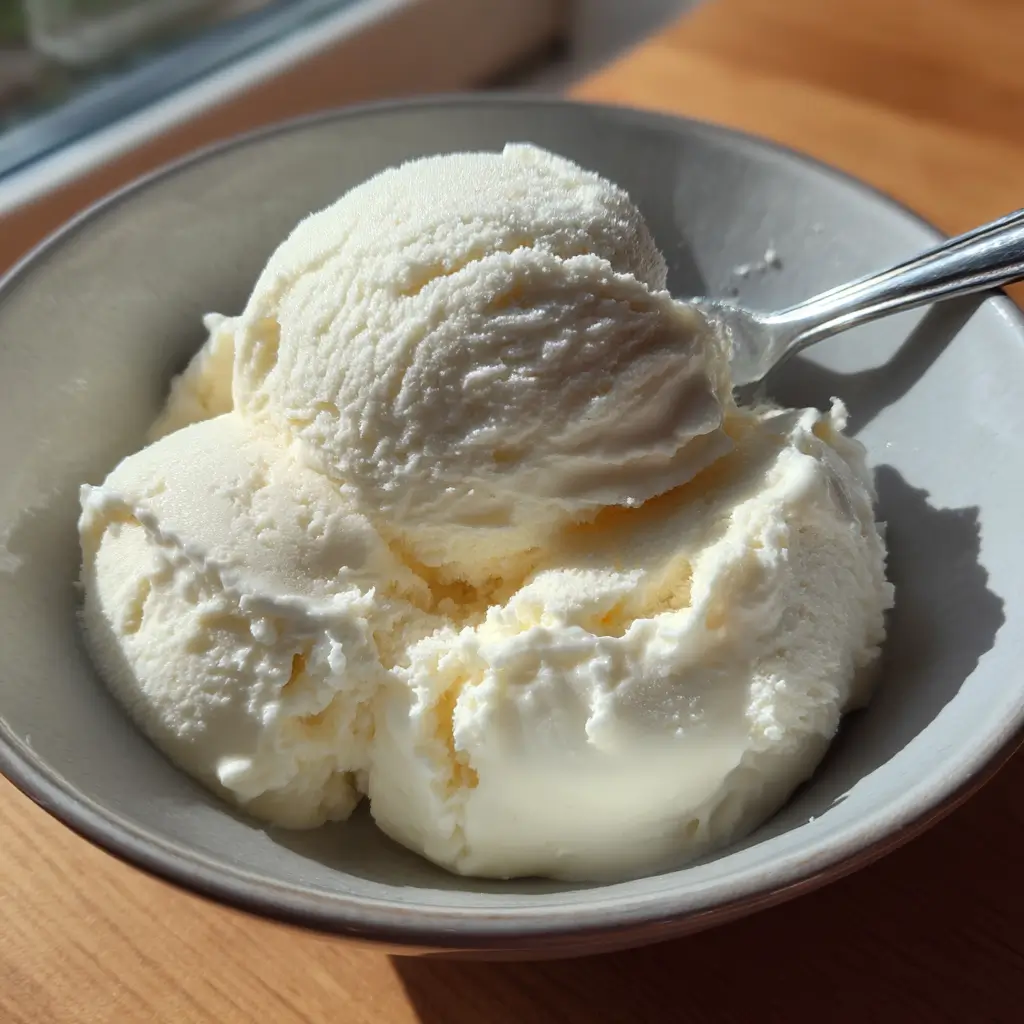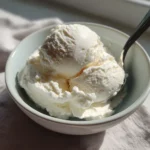Ice cream is a beloved treat—but for many, dairy can turn that indulgence into discomfort. Whether you’re lactose intolerant, vegan, or simply looking to cut back on animal products, dairy free ice cream offers a delicious, creamy alternative without the digestive drama. In this comprehensive guide, we’ll explore what makes non-dairy ice cream so popular, how it compares to traditional versions, and how to make or choose the best ones for your lifestyle. You’ll also get a look at real-life experiences, best brands, health benefits, and expert tips for taste and texture.
Table of Contents
Don’t miss our tips on making dairy-free ice cream at home, plus answers to the most common questions about lactose-free living.
PrintHomemade Dairy Free Vanilla Ice Cream
Blend all ingredients until smooth.
Chill mixture for 1–2 hours.
Churn in an ice cream maker for 20–30 minutes.
Freeze until solid.
Scoop and serve.
- Prep Time: 10 minutes
- Cook Time: 2,10 hours
- Total Time: 3 hours
- Yield: 1 pint (~4 servings) 1x
- Category: Dessert
- Method: No-Bake, Ice Cream Maker
- Cuisine: American
- Diet: Gluten Free
Ingredients
2 cans full-fat coconut milk
⅓ cup maple syrup
2 tsp vanilla extract
1 tbsp arrowroot starch
Pinch of salt
Instructions
Blend all ingredients until smooth.
Chill mixture for 1–2 hours.
Churn in an ice cream maker for 20–30 minutes.
Freeze until solid.
Scoop and serve.
Notes
For extra creaminess, use 100% coconut milk and skip almond milk.
Add crushed vanilla bean for a gourmet twist.
No ice cream maker? Freeze the base in a shallow pan and stir every 30 mins until creamy.
Nutrition
- Serving Size: 4 servings
- Calories: ~210
- Sugar: ~18g
- Sodium: ~45mg
- Fat: ~14g
- Saturated Fat: ~12g
- Unsaturated Fat: 2g
- Trans Fat: 0g
- Carbohydrates: ~22g
- Fiber: ~1g
- Protein: ~2g
- Cholesterol: 0Mg
Understanding Dairy Free Ice Cream
What is Dairy Free Ice Cream?
Dairy free ice cream is a frozen dessert made without any milk or cream derived from animals. Instead, it uses plant-based ingredients like coconut milk, almond milk, soy milk, cashew milk, or oat milk as its creamy base. These alternatives mimic the smooth texture of dairy while avoiding the lactose, casein, and whey proteins that can trigger allergies or intolerances.
Not to be confused with “sorbet” or “fruit ice,” dairy-free ice cream often includes emulsifiers and fats from non-dairy sources to replicate the richness of traditional ice cream.
How It Differs from Traditional Ice Cream
The primary difference lies in the source of fat and creaminess. Traditional ice cream relies on animal milk and heavy cream, whereas dairy-free versions use plant fats and starches. Here’s how they compare:
| Feature | Traditional Ice Cream | Dairy Free Ice Cream |
|---|---|---|
| Base | Cow’s milk or cream | Coconut, almond, soy, oat, cashew |
| Lactose | Present | Absent |
| Vegan-Friendly | No | Usually yes |
| Common Allergens | Dairy, casein | May include soy or nuts |
Dairy-free versions also tend to be lower in saturated fats (depending on the base) and more inclusive for people with dietary restrictions.
Benefits of Dairy Free Ice Cream
Health Benefits: Lactose-Free, Lower Cholesterol, and Fewer Allergens
One of the biggest draws of dairy free ice cream is that it’s completely lactose-free. For the estimated 36% of Americans who suffer from lactose intolerance, switching to a non-dairy option can mean enjoying ice cream again—without the gas, bloating, or discomfort.
But the benefits don’t stop there. Many dairy-free alternatives are also:
- Cholesterol-Free – Since cholesterol comes only from animal products, dairy-free desserts made from plants are naturally cholesterol-free, promoting heart health.
- Lower in Saturated Fat – Except for coconut-based varieties, most non-dairy ice creams use fats that are less saturated, helping maintain better lipid profiles.
- Allergen-Friendly – Some dairy-free brands are also free from soy, nuts, and gluten, making them safer for people with food allergies.
Expanding your dairy-free menu? Our Dairy-Free Pizza recipe proves you don’t need cheese to enjoy a slice that’s savory, melty, and absolutely satisfying.
Here’s a quick comparison of the common health benefits:
| Benefit | Dairy Ice Cream | Dairy Free Ice Cream |
|---|---|---|
| Lactose-Free | ❌ | ✅ |
| Vegan | ❌ | ✅ |
| Cholesterol-Free | ❌ | ✅ |
| Nut-Free Options | ❌ (usually not) | ✅ (some brands) |
| Gluten-Free | ✅ (some) | ✅ (most) |
Who Should Consider Dairy-Free Alternatives?
You don’t have to be vegan to enjoy dairy-free desserts. Here’s who can benefit:
- Lactose-Intolerant Individuals: No more stomach cramps or running to the bathroom.
- Vegans and Plant-Based Eaters: Aligns with ethical and dietary choices.
- People with Dairy Allergies: Avoids casein and whey proteins.
- Health-Conscious Consumers: Lower saturated fat and zero cholesterol options.
- Environmental Advocates: Plant-based products have a smaller carbon footprint.
Transitioning to dairy free ice cream isn’t just a dietary switch—it’s a lifestyle choice that can align with wellness, ethics, and sustainability.
If you’re wondering about fruity frozen options, check out our article on Is Sherbet Dairy Free?—the answer might surprise you!
Best Ingredients Used in Dairy Free Ice Cream
Popular Bases: Coconut, Almond, Cashew, Oat, and Soy
The foundation of any dairy free ice cream is its base, and not all bases are created equal. Each plant-based option brings its own flavor, texture, and nutritional profile.
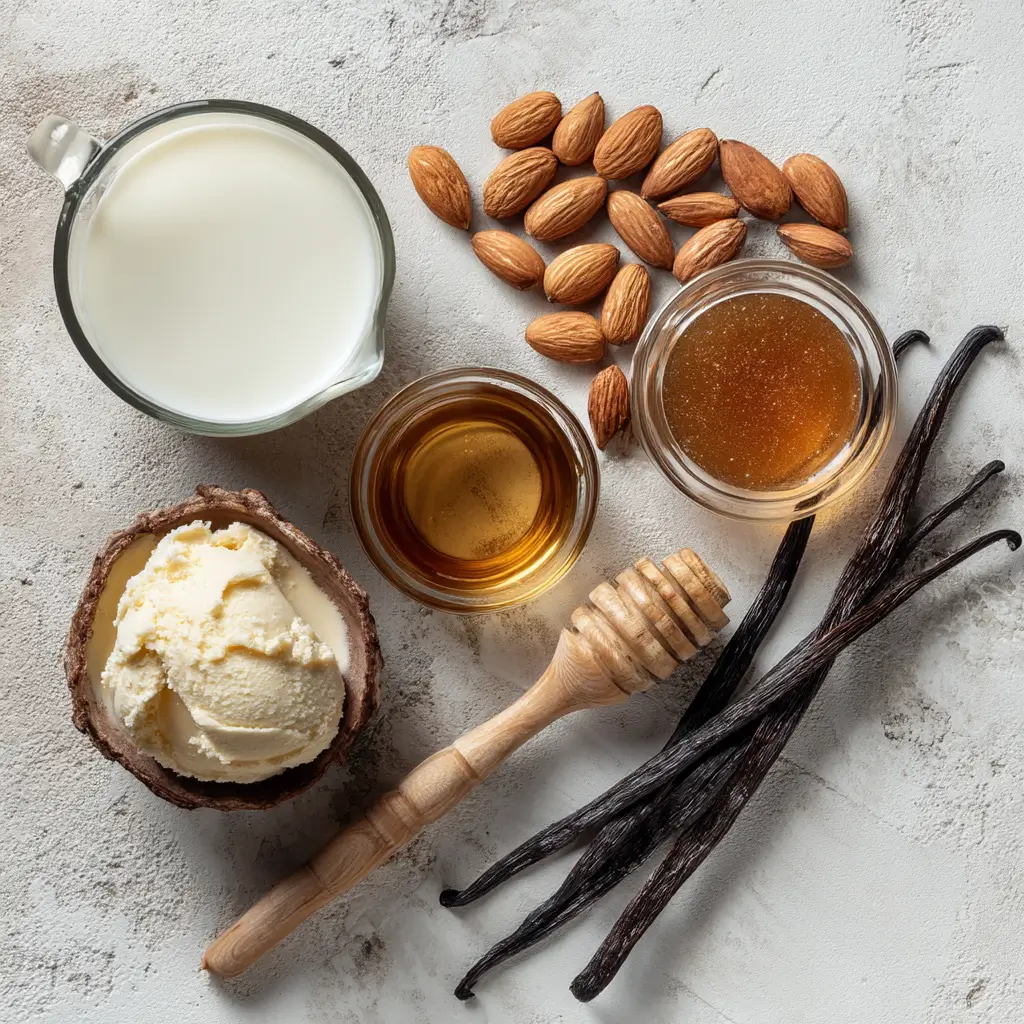
Here’s a breakdown of the most common non-dairy bases:
- Coconut Milk
Thick, rich, and naturally sweet, coconut milk delivers a creamy texture that’s closest to traditional ice cream. However, it’s high in saturated fat, which some consumers avoid. - Almond Milk
A lighter option, almond milk is subtle in taste and works well in fruit-based or vanilla flavors. It’s lower in calories but may have a thinner consistency. - Cashew Milk
Ultra-creamy and neutral in flavor, cashew milk is often considered the best base for recreating a silky, indulgent texture. - Oat Milk
Oat milk has surged in popularity due to its sustainable production and creamy feel. It adds a slightly sweet, earthy tone and is allergen-friendly (nut- and soy-free). - Soy Milk
High in protein and widely available, soy milk delivers a traditional mouthfeel. However, it may not be suitable for those with soy sensitivities.
Here’s a quick comparison:
| Plant-Based Milk | Creaminess | Flavor | Common Use |
|---|---|---|---|
| Coconut | High | Sweet, rich | Tropical, vanilla |
| Almond | Medium | Nutty, subtle | Chocolate, berry |
| Cashew | High | Neutral, creamy | Gourmet flavors |
| Oat | High | Earthy, sweet | Cookies & cream |
| Soy | Medium | Nutty | Classic vanilla, chocolate |
Natural Sweeteners and Thickeners for Dairy-Free Creaminess
Creating the right texture without cream is a challenge, but modern dairy-free brands use clever techniques and ingredients to get it right:
Sweeteners:
- Maple syrup, agave nectar, and dates are popular in homemade recipes.
- Some brands also use monk fruit, erythritol, or stevia for lower sugar options.
Thickeners & Emulsifiers:
- Guar gum: Adds thickness and smoothness.
- Locust bean gum: Improves mouthfeel.
- Tapioca starch: Helps with binding and creaminess.
- Sunflower lecithin: Acts as an emulsifier.
These help replicate the luxurious, scoopable quality that defines classic ice cream—without a single drop of dairy.
How to Make Dairy Free Ice Cream at Home
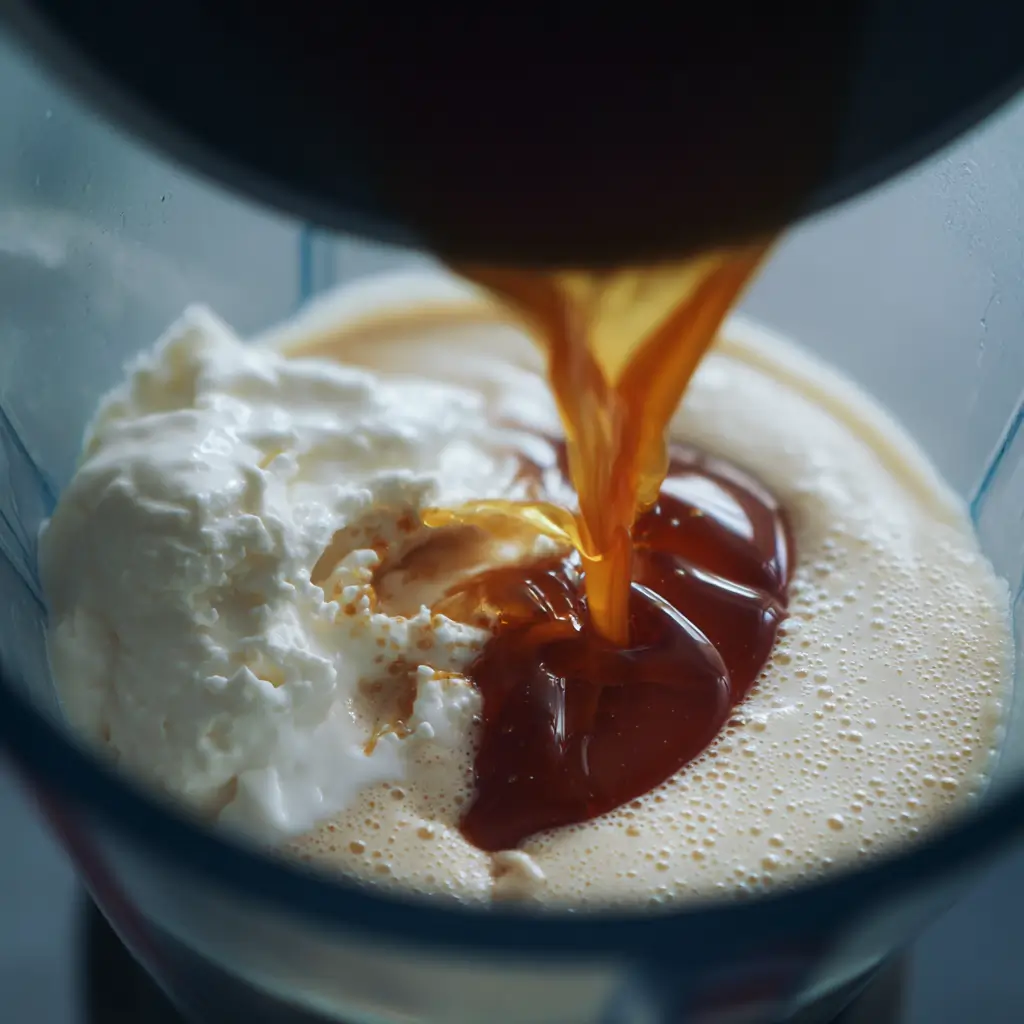
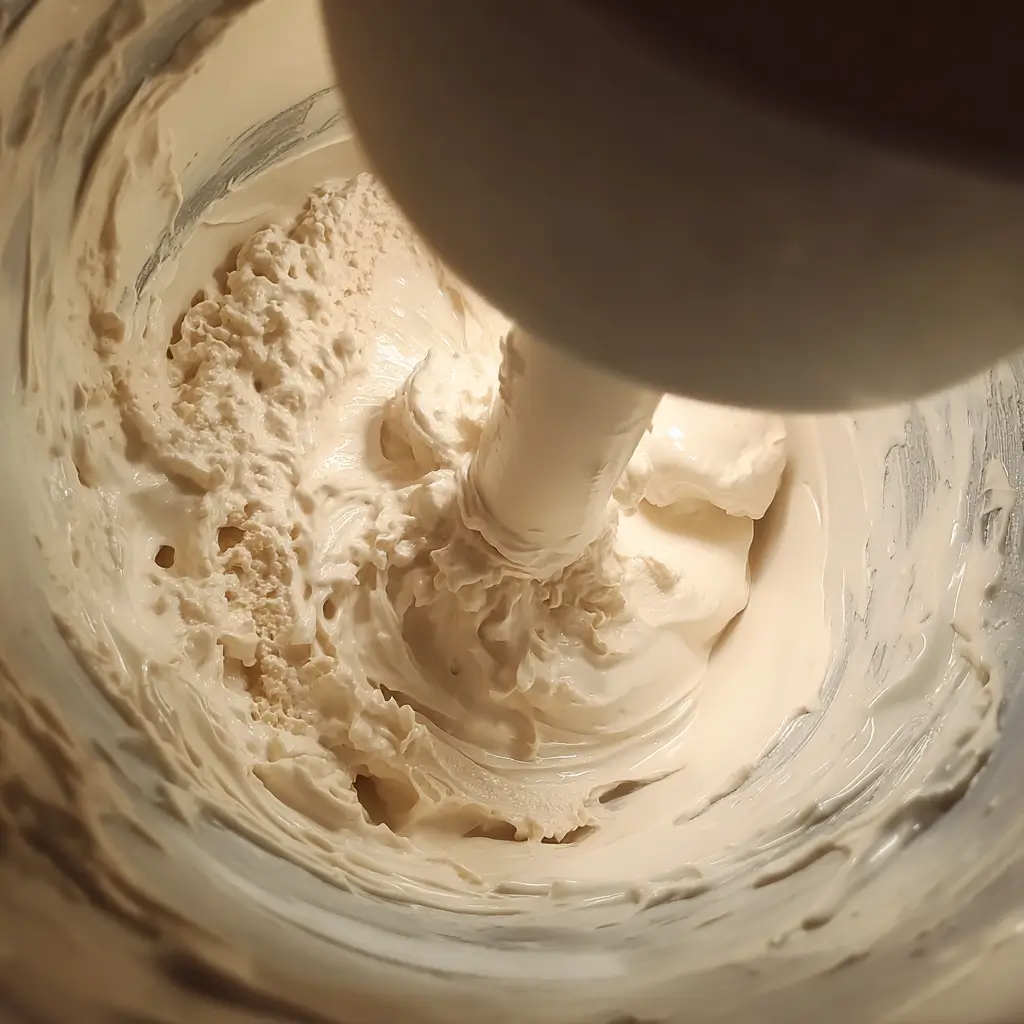
Essential Tools & Ingredients to Get Started
Making your own dairy free ice cream at home is easier than you think—and you don’t need fancy equipment to get started. Here’s what you’ll need:
Basic Equipment:
- Blender (high-speed preferred for smooth texture)
- Ice cream maker (optional but recommended)
- Mixing bowls
- Freezer-safe container with lid
- Spatula or ice cream scoop
Staple Ingredients (depending on your base):
- 2 cups of plant-based milk (coconut, cashew, oat, etc.)
- ½ cup of natural sweetener (maple syrup, agave, or soaked dates)
- 1 tsp vanilla extract
- Pinch of salt
- Optional: cocoa powder, fruit puree, nut butter, or chocolate chips
For added creaminess:
- 1 tbsp coconut oil or nut butter
- 1 tsp guar gum or arrowroot powder for a softer scoop
Pro Tip: Chill your ingredients beforehand for faster churning and better texture.
Want to take it up a notch? Try our Dairy Free Ice Cream Cake recipe for a festive, layered dessert that’s completely dairy-free—perfect for birthdays, celebrations, or just when you’re craving something special.
Step-by-Step Recipe: Easy Homemade Dairy-Free Ice Cream
Here’s a simple recipe using a coconut milk base that yields rich, creamy results.
Recipe: Vanilla Coconut Milk Ice Cream
Ingredients:
- 2 cans (13.5 oz) full-fat coconut milk
- ⅓ cup maple syrup
- 2 tsp vanilla extract
- Pinch of sea salt
- 1 tbsp arrowroot starch (optional for smooth texture)
Instructions:
- Blend all ingredients in a blender until smooth.
- Chill the mixture in the fridge for 1-2 hours (or overnight).
- Churn in an ice cream maker for 20–30 minutes, or until thick and creamy.
- Transfer to a freezer-safe container, smooth the top, and cover.
- Freeze for 4–6 hours or until firm.
- Scoop and serve! Let sit at room temperature for 5–10 minutes if too firm.
No Ice Cream Maker?
Pour the blended mixture into a shallow tray. Freeze for 30 minutes, stir vigorously, and repeat every 30 minutes for 2–3 hours.
You can customize your base with:
- Strawberries for a fruity flavor
- Peanut butter for a nutty twist
- Dark chocolate chunks for extra indulgence
Want to take it up a notch? Try our Dairy Free Ice Cream Cake recipe for a festive, layered dessert that’s completely dairy-free—perfect for birthdays, celebrations, or just when you’re craving something special.
For a lighter option packed with nutrition, check out our collection of Dairy-Free Protein Shakes—perfect as a refreshing dessert alternative or post-workout pick-me-up.
Top Store-Bought Dairy Free Ice Cream Brands
A Look at Leading Brands: So Delicious, NadaMoo!, Oatly, Ben & Jerry’s Non-Dairy Line
With rising demand for dairy free ice cream, top brands have stepped up to offer delicious, creamy options in grocery freezers across the USA. Whether you’re lactose-intolerant, vegan, or just exploring plant-based desserts, here are some standout names to try.
1. So Delicious
One of the pioneers in the non-dairy space, So Delicious offers options made with coconut milk, almond milk, and cashew milk. Their wide flavor range includes fan favorites like Snickerdoodle, Salted Caramel Cluster, and Chocolate Cookies ‘n’ Cream.
- Plant-Based Milk: Coconut, Cashew, Almond
- Vegan: Yes
- Gluten-Free: Most options
- Standout Flavor: Chocolate Drizzled Bananas Foster
2. NadaMoo!
Made from organic coconut milk, NadaMoo! focuses on clean ingredients and low glycemic sweeteners. It’s a great choice for those watching their sugar intake.
- Plant-Based Milk: Coconut
- Vegan: Yes
- Gluten-Free: Yes
- Standout Flavor: Birthday Cake Cookie Dough
3. Oatly
Oatly has quickly become a favorite for oat milk lovers. Their non-dairy ice creams are smooth and subtly sweet, with less fat than nut-based alternatives.
- Plant-Based Milk: Oat
- Vegan: Yes
- Gluten-Free: No (check label)
- Standout Flavor: Strawberry Swirl
4. Ben & Jerry’s Non-Dairy Line
Yes, the iconic brand went plant-based too. Using almond milk and now sunflower butter, they deliver indulgent, chunky classics—without the dairy.
- Plant-Based Milk: Almond, Sunflower Butter
- Vegan: Yes
- Gluten-Free: Some options
- Standout Flavor: Netflix & Chilll’d Non-Dairy
Comparison Table of Price, Ingredients, and Flavor Range
| Brand | Base Milk | Vegan | Price Range | Flavors Available | Best For |
|---|---|---|---|---|---|
| So Delicious | Coconut/Cashew | ✅ | $4.50–$6 | 15+ | Variety, creaminess |
| NadaMoo! | Coconut | ✅ | $5.99 | 10+ | Clean label, low sugar |
| Oatly | Oat | ✅ | $4.99 | 8 | Mild flavor, allergen-friendly |
| Ben & Jerry’s | Almond/Sunflower | ✅ | $5.49–$6.49 | 12+ | Indulgent, chunky mixes |
Pro Tip: Always read the ingredient list—even vegan ice creams can contain added sugars, gums, or allergens depending on the brand.
From fruity to decadent, there’s a non-dairy pint out there for every taste and preference. Many stores also carry their own vegan lines, so don’t be afraid to experiment!
Taste and Texture: What to Expect
Does Dairy Free Ice Cream Taste Like the Real Thing?
One of the most common questions from first-time buyers is, “Does dairy free ice cream taste the same as regular ice cream?” The answer: It depends on the base, brand, and flavor.
Some coconut or oat-based options deliver a near-identical creamy mouthfeel, while others (especially those with fewer fats) might feel lighter and slightly icy.
Here’s what you can generally expect:
- Coconut milk ice creams: Rich, creamy, with a subtle coconut undertone. Works great with tropical or chocolate flavors.
- Cashew-based ice creams: Smooth and neutral, these are often closest in texture to dairy ice cream.
- Oat milk ice creams: Soft and subtly sweet, ideal for those who prefer a lighter finish.
- Soy-based options: High in protein but may have a distinct “beany” aftertaste.
Also, flavor intensity can differ—since dairy often dulls flavors slightly, non-dairy versions may taste sweeter or more pronounced.
Tips for Improving Texture and Mouthfeel at Home
If you’re making dairy free ice cream at home, getting that perfect scoopable consistency can be tricky. Here are some expert tips to nail the texture:
1. Use Full-Fat Milk Alternatives
Always go with full-fat canned coconut milk, homemade cashew cream, or high-fat oat milk. Fat equals creaminess.
2. Add Natural Thickeners
Use ingredients like:
- Arrowroot powder
- Cornstarch
- Xanthan gum
These help stabilize the mixture and prevent ice crystals.
3. Blend, Chill, and Churn Properly
Blending your mix at high speed breaks down solids and air pockets. Chilling before churning improves emulsification, and steady churning ensures a smoother end result.
4. Let It Sit Before Scooping
Straight from the freezer, any ice cream—even dairy—can be rock-hard. Let it soften for 5–10 minutes at room temperature to enhance creaminess.
5. Add Liquor or Sugar Alcohols
Small amounts of vodka or maple syrup lower the freezing point, which helps keep the dessert scoopable without affecting flavor.
Here’s a quick texture checklist for success:
| Ingredient | Role | Texture Impact |
|---|---|---|
| Full-fat base | Creaminess | Rich, smooth body |
| Gum/thickener | Stability | Prevents iciness |
| Sugar | Softness | Adds flexibility |
| Oil (e.g. coconut oil) | Body | Adds dense creaminess |
While not every dairy free ice cream will match the exact flavor of its dairy counterpart, many come very close—especially when enhanced with the right ingredients and techniques.
Is Dairy Free Always Healthier?
Hidden Sugars and Additives to Watch Out For
While dairy free ice cream is often seen as the healthier alternative, not all options are created equal. The truth is, some plant-based pints can be loaded with added sugars, processed thickeners, and calorie-dense fats.
Let’s break down what to watch for:
1. Added Sugars
Many brands load up on sugar to make up for the flavor and texture difference. Look for names like:
- Cane sugar
- Corn syrup
- Brown rice syrup
- Tapioca syrup
Always check the “Added Sugars” line in the nutrition label. Some dairy-free pints contain more sugar than regular ice cream.
2. Gums and Fillers
Thickeners like guar gum, locust bean gum, and xanthan gum are used to recreate creaminess. While generally safe, overuse can cause digestive discomfort in some people.
3. Fat Content
Coconut-based ice creams, while creamy, are high in saturated fats—sometimes even higher than dairy. Not all plant-based options are low-fat.
4. Portion Size Confusion
“Vegan” and “dairy free” labels create a health halo. Many people end up eating more, assuming it’s guilt-free.
Here’s an example of what to compare on a label:
| Nutrient | Recommended | Watch Out For |
|---|---|---|
| Sugars | Under 10g per serving | Over 15g per serving |
| Saturated Fat | Under 4g | Over 7g (esp. coconut base) |
| Total Calories | 150–200 per serving | 250+ per serving |
| Fiber | 1–3g | 0g (lack of whole ingredients) |
Reading Labels: Vegan Doesn’t Always Mean Healthy
Want to know how veganism and dairy-free choices overlap? We dive deep into it in Is Vegan Dairy Free?.
Here’s the deal: “Vegan” doesn’t always equal healthy. Some dairy-free products contain:
- Artificial flavors
- Food dyes
- Palm oil (linked to environmental harm)
- Emulsifiers that affect gut microbiota in high amounts
Instead, choose options with short ingredient lists, preferably with recognizable foods:
- Real fruits
- Plant-based milk
- Natural sweeteners like dates or agave
- Organic or non-GMO certifications
Also, consider options with added benefits like:
- Probiotics
- Fiber
- Low glycemic sweeteners
Pro Tip: If you’re buying for kids or anyone with dietary sensitivities, always double-check for cross-contamination warnings (e.g. “may contain traces of dairy”).
While dairy free ice cream can be part of a healthy lifestyle, it’s important to stay label-savvy and avoid assuming that “non-dairy” automatically means “better for you.”
Real-Life Experiences and Digestive Impact
Why Ice Cream Hurts My Stomach but Other Dairy Doesn’t (Personal Insight)
Ever wondered, “Why does ice cream mess with my stomach, but cheese or yogurt doesn’t?” You’re not alone. For many, ice cream is the ultimate gut-wrecker, even when other dairy foods are well tolerated.
Here’s why that might happen—straight from personal experience and digestive science.
1. Higher Lactose Load
Ice cream typically contains more lactose per serving than other dairy products. It’s a double whammy: you’re eating a cold, rich dessert filled with sugar + lactose, both of which can irritate a sensitive gut.
2. Low Lactase Enzyme
If you’re lactose intolerant, your body lacks enough lactase, the enzyme needed to break down lactose. That unprocessed sugar then ferments in your gut, causing:
- Gas
- Bloating
- Diarrhea
- Stomach cramps
Cheese and yogurt often contain less lactose due to fermentation or processing—making them easier to digest for some people.
3. Cold Temperature Effect
Cold foods can slow digestion and trigger stomach spasms in some people, making the discomfort from lactose even worse.
4. Additives & Sugar
Many commercial ice creams contain emulsifiers, gums, and high amounts of refined sugar—all of which can disrupt your gut flora or cause discomfort, especially if eaten in large quantities.
Personal note:
After years of eating ice cream and wondering why I felt like a balloon afterward, switching to dairy free ice cream was a game changer. Coconut-based treats gave me the flavor I craved, without the hours of bloating and regret.
Can I Eat Chick-fil-A If I’m Lactose Intolerant? (Personal Perspective)
As someone with lactose sensitivity, fast food is always a gamble—especially when dairy’s hidden in sauces, breads, and batters.
When it comes to Chick-fil-A, here’s my honest breakdown:
Safe Picks for the Lactose Intolerant:
- Grilled Chicken Sandwich (no cheese, no bun or opt for gluten-free bun)
- Waffle fries (surprisingly dairy-free!)
- Market Salad without cheese
- Fruit cups or kale crunch salad
What to Avoid:
- Milkshakes (obviously, full dairy)
- IceDream Cone – Yes, it contains dairy (see Part FAQ)
- Mac & Cheese
- Battered items – may contain milk-derived ingredients
What Helped Me:
I started checking Chick-fil-A’s Allergen Menu online before ordering. Swapping the regular bun and skipping cheese helped me enjoy a meal without the aftermath. But overall, I’d avoid their desserts and creamy sauces if you’re dairy-sensitive.
Pro Tip:
Always ask for ingredient info at the counter—or check their website. Many chains update recipes, and what was safe last month may not be today. K,LM
FAQs About Dairy Free Ice Cream
Is Chick-fil-A Ice Cream Dairy-Free?
No, Chick-fil-A’s signature Icedream® cone is not dairy-free. Despite its light texture and the misleading “ice dream” name, it contains milk and milk derivatives, which makes it unsuitable for anyone who is lactose intolerant or following a dairy-free diet.
If you’re craving something cold and sweet from Chick-fil-A, unfortunately, there isn’t a current dairy-free dessert option on the menu. Your best bet? Bring your own pint of dairy free ice cream and skip the drive-thru.
Why Does Ice Cream Hurt My Stomach but Not Other Dairy?
It’s a common issue. Ice cream contains more lactose and refined sugars than many other dairy products. Even if you can tolerate cheese or yogurt, ice cream might overwhelm your gut because:
It’s usually eaten cold, slowing digestion
It’s rich in sugar and fats, which can irritate sensitive systems
It has a high lactose concentration per serving
Also, additives in commercial ice cream (like gums and emulsifiers) can disrupt your gut balance, especially in large amounts. Switching to dairy free ice cream can often eliminate these symptoms entirely.
Does Mayonnaise Have Dairy?
Nope! Traditional mayonnaise is dairy-free. It’s made from eggs, oil, and acid (like vinegar or lemon juice). While eggs are an animal product, they are not dairy, meaning mayo is safe for people avoiding milk and its derivatives.
However, flavored or specialty mayos (like chipotle mayo or ranch-style mayo) might include milk-based ingredients—so it’s always smart to check the label if you’re aiming for 100% dairy-free living.
Another common question we get is about ghee. You can explore whether it fits your lifestyle in our article Is Ghee Dairy Free?.
Can I Eat Chick-fil-A If I’m Lactose Intolerant?
Yes, but carefully. Chick-fil-A offers several menu items that are safe for lactose-intolerant customers, such as:
Grilled chicken entrees (without cheese or creamy sauces)
Waffle fries
Side salads without cheese
Fruit cups
However, be sure to avoid dairy-heavy items like:
Icedream desserts
Milkshakes
Mac & Cheese
Creamy dressings
As always, check their allergen guide or ask staff about current ingredients. And when in doubt, go with plain grilled items and water-based sides.
Final Scoop: Why Dairy Free Ice Cream Deserves a Spot in Your Freezer
Whether you’re navigating lactose intolerance, exploring a plant-based lifestyle, or just curious about alternatives, dairy-free ice cream has something sweet to offer. From coconut milk swirls to cashew cream creations, today’s options are rich, indulgent, and better than ever.
We’ve covered everything from how it’s made and how it tastes, to the top brands and homemade tips that make the switch easier (and yummier). If you’re looking for a frozen dessert that skips the stomach issues but keeps all the joy—dairy-free might just be your new go-to.
👉 Ready to dive deeper into delicious dairy-free recipes?
Follow us for daily inspiration, exclusive tips, and tasty new ideas:
Keep your freezer stocked and your cravings happy—with clean, creamy, and completely dairy-free goodness.
